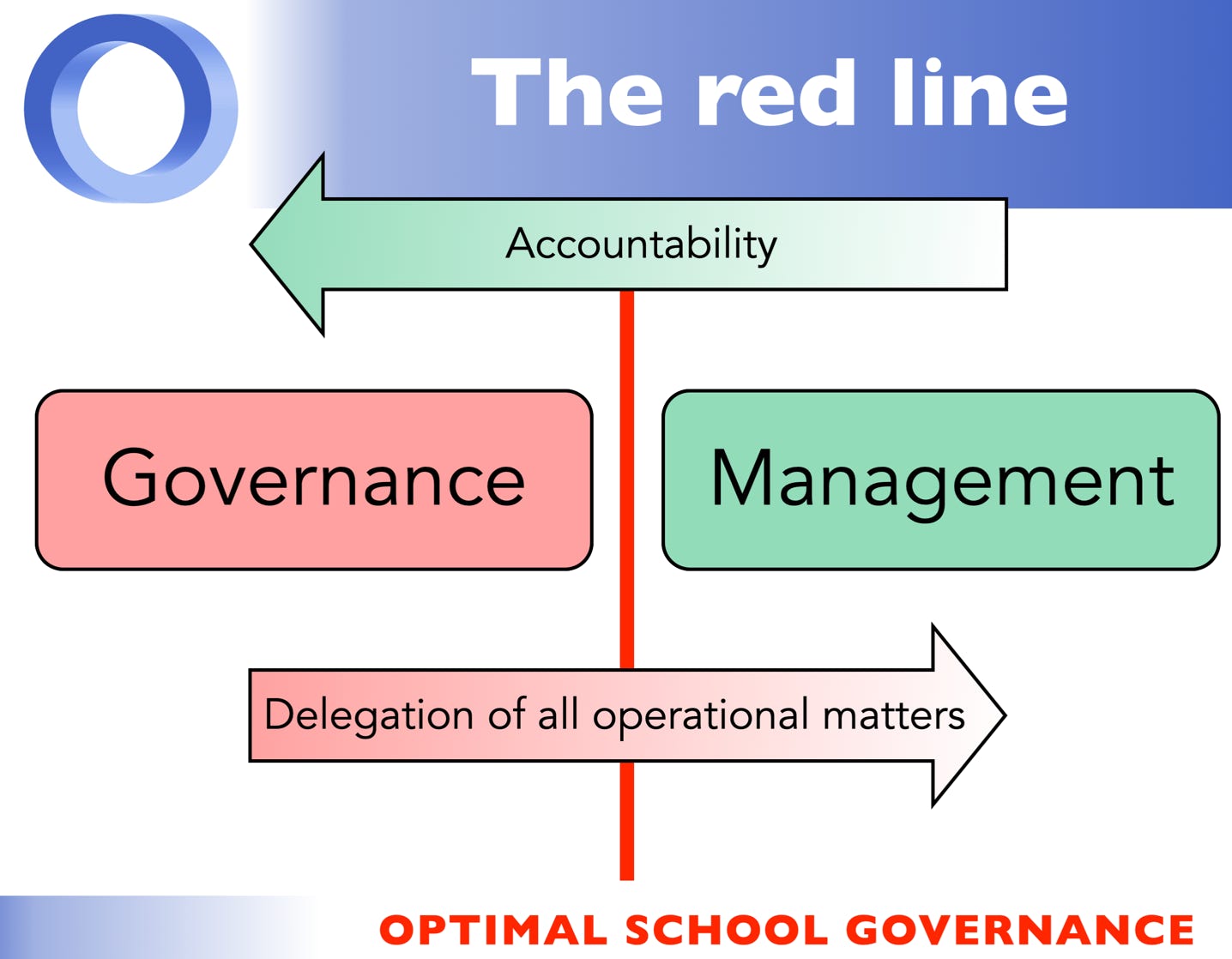Articles
The purpose of a school board is to govern the school. The purpose of the staff and its leadership is to manage the school. The so-called Red Line that divides the roles of Governance and Management is the most basic element of sound leadership in schools – and often the least understood or most ignored.
The Board’s duty of Governance arises from its legal authority to exercise power and authority to ensure legal compliance, make sure risk is managed, ensure financial viability, set and monitor the mission, vision and direction of the school, engage and support the Principal, and so on. Governance is thus a future-focussed, collective or group action – the Board’s authority arises when it meets and makes resolutions.
The Board delegates authority to the Principal to manage the school’s day-to-day operations in such a way that the mission and vision are achieved, financial sustainability is secured, legal requirements are met, risk (including health and safety) are managed effectively, and so on. Of course, the Principal is not expected to achieve this single-handedly, and therefore management involves the delegation of tasks and outcomes to teaching and non-teaching staff, all of whom are recruited and managed as part of the Principal’s responsibilities.

A two-way delegation and accountability relationship therefore arises between the Board and the Principal. The Board delegates all operational matters to the Principal but remains ultimately accountable to ensure that its mission and objectives are achieved. Therefore, the Principal provides regular reports to the Board on the state of the school, with special emphasis on the strategic goals that the Board has set. This allows the Board as a collective body to monitor the progress of the school in achieving its objectives (and parenthetically also the Principal’s effectiveness in implementing their delegated authority).
It’s all so clear – Boards govern and Principals manage, Boards focus on the future while Principals act in the present, Boards determine the mission and the goals while Principals operationalise and implement the same mission and goals. Discrete roles and responsibilities, separated by a clear, thick, Red Line, but linked by a strong delegation-accountability relationship. It sounds like a formula for perfect teamwork. WHAT COULD POSSIBLY GO WRONG?
The short answer is “plenty”, as many Principals and Board members will attest.
Sometimes, friction arises simply because well-meaning but untrained Board members (or the Principal) don’t fully understand the different roles and responsibilities that lie on either side of the Red Line.
On other occasions, a weak or ineffective Board might ‘force’ a Principal to take on some of the functions of governance. Equally, a weak or ineffective Principal may ‘compel’ the Board to intrude into aspects of day-to-day operational management, even to the point of micro-management. The relationship works best when a school has a strong Board and an equally strong Principal, each of whom understands their respective roles and responsibilities.
There is also a more subtle reason that complicates the relationship. Some areas of management (the Principal’s responsibility) may have strategic elements (the Board’s responsibility). For example, enrolment management, disciplinary issues, hiring and firing of staff are management responsibilities that may, on some occasions, cause huge strategic or reputational implications with the potential to derail the school, at which point the Board needs to become involved.
If an issue becomes so significant that it might affect the enrolments of the school, or its reputation, or the school’s viability, then the Red Line becomes a Grey Zone. In such situations, communication is the key – urgent, frank, creative (and probably closed-door) discussions are needed between the Board Chair and the Principal to develop a common, coherent, co-ordinated action plan.
I wish I could remember who it was (and I can no longer find it online) – but in the discussion thread of a TED talk about 15 years ago, someone posted a comment that has stayed with me ever since: “the grey areas are where you find the complexity, the humanity, and the truth”.
Schools are complex, people-focussed communities where discernment of truth is by definition a key goal. Understanding when the Red Line should be held rigidly in place and when the Grey Zone can and ought to intrude is a key capacity in which the Board and the Principal together can model agile, authentic, effective leadership for staff, students and parents alike.
-Dr Stephen Codrington
The information in this article is expanded in workshops such as OSG-S4 Governance and Management as well as in the book "Optimal School Governance", which can be ordered directly through Pronins.
You may also be interested in previous articles which are archived at https://optimalschool.com/articles.html.